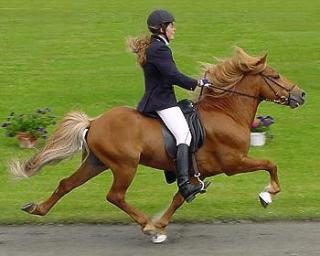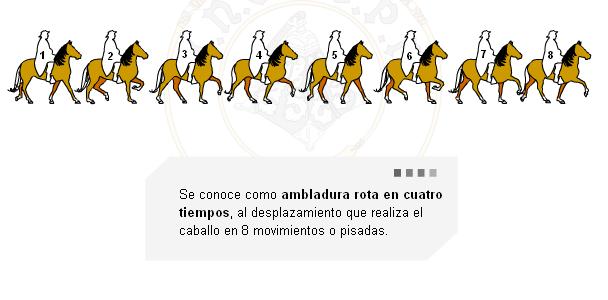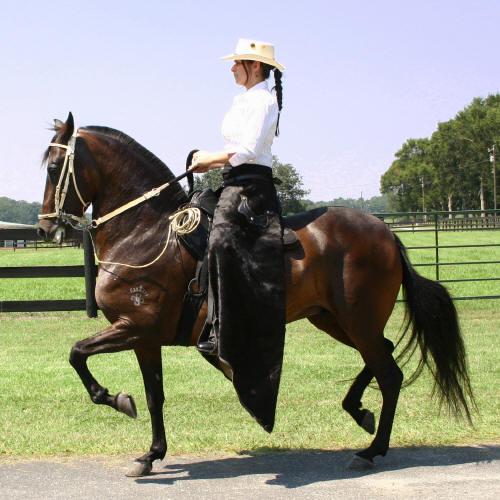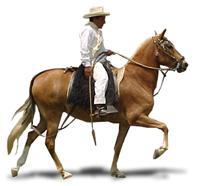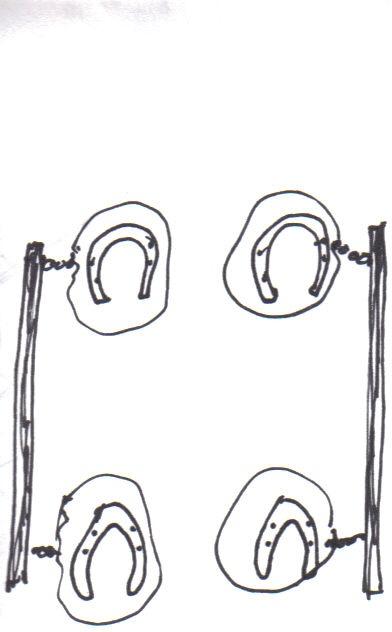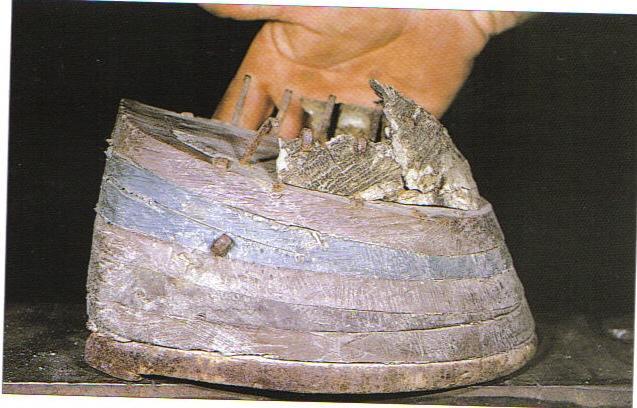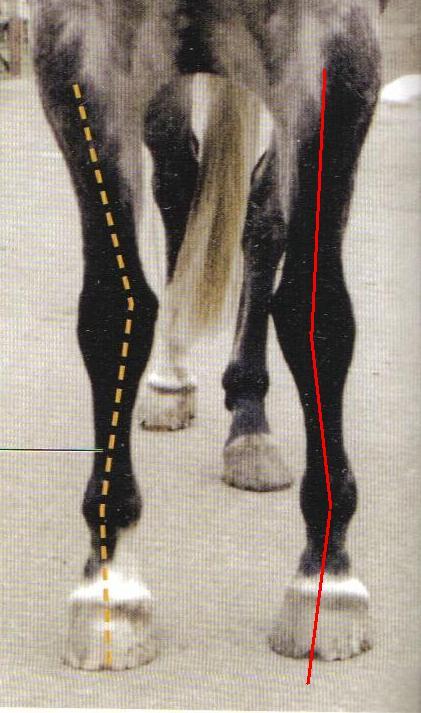Dicen los herradores que se deben herrar como cualquier otro caballo, aunque a veces tienen herraduras distintas. Puedes ver lo en
http://www.horsesales.com/saddlbre.htm (abajo del todo)
luego hay los con poco escrupulos que usan todo tipo de torturas para que estos caballos se elevan mejor. (lo siento esta en ingles, pero a ver si alguien puede traducir. TWH es Tenesee Walking Horse
Pressure Shoeing!
Pressure shoeing is a method of shoeing that utilizes the sole, most often the portion between the frog and the white line. Since the sole is NOT a primary weight bearing structure, this causes increased sensitivity (pain!) at the toe and often results in the horse having exaggerated action. In other words, the horse is purposely made sore in order to achieve a more "animated" gait.
This shoeing method is one of the favorite methods of torture in plantation and lite shod Tennessee Walker show horses.
Why do some of the TWH show element abuse their horses with pressure shoeing? Simple: a horses foot will move TOWARD weight and length and AWAY from pain. Hence a higher more animated action.
Pressure shoeing can be accomplished by several means. First, the sole is removed to the point just before the horse starts to bleed, (or just after, a little blood doesn't hurt anything) usually to a degree that the horse's>pulse can be felt through the sole at the toe. Next, the wall is trimmed at an angle, so it's slightly shorter than the sole at the toe. This allows the shoe's web (or nail pad) to exert pressure on the sole when the shoe is nailed on. (many over the counter plantation shoes are made higher on the inside than the outside) The pressure is constant and there's no way for the horse to get away from it, other than to lie down. Pressured horses lay down a lot.
In the non-padded sector of TWH show horses, the more imaginative "show shoers" catering to the win-at-all-cost "trainers" sometimes run a bead of weld on the foot surface of the inner web of the shoe which puts pressure on the sensitized area without the necessity of lowering the wall. Some have also been known to weld a matrix on the inner web of the shoe, although the matrix can cause a bit of external bleeding which might get a DQP's attention.
The padded folks sometimes concentrate pressure on a sensitized portion of the sole by inserting something hard in the nail pad next to the frog. Golf balls, ball bearings, marbles, and even rocks have been used. (they can always say that the rock got in there by "accident")
Another method I have been told about on lite shod and plantation horses is to shoe the horse in the traditional manner, then take a large pair of channel lock pliers, or a small vice and squeeze the heels together 3/16" - 5/16" And yet another method is to use a V shaped heel-spreading spring. Wrap a big wad of black electrical tape around the V part, Position this wad about 1/2" in front of the frog. Work the horse in this contraption on firm footing til just before show time, then remove it. The only way to tell this from a stone bruise is that it is bi-lateral!
If the horse is unpadded, a credit card or metal feeler gauge or something similar can be used to test the clearance between shoe and sole. If your gauge bumps against resistance you might have a problem. Obviously, if the TWH show folks really wanted to stop the abuse, they'd start pulling shoes.
The following is a note that I recieved from a respected farrier about the effects of heel calks. I agree with him completely.
Assuming a short, balanced foot, at any established gait, the front foot of a sound horse will land flat on a level surface at the first phase of motion, impact. Barefoot or shod with a flat shoe, at liberty, under saddle or being driven, the foot will still land flat. The foot lands flat because that's anatomically the most efficient way for the horse's foot to deal with stress.
As you know, the bones within the hoof capsule are attached to the wall by means of laminae which arise from the coronary and dermal coriums of the coronary band and third phalanx respectively. Not only to the laminae serve as a means of attachment, they also provide the horse with a hydraulic means of dealing with the stress inherent to the loading of the hoof capsule on impact.
The blood within the laminae and the incompressibility of fluids provide the hoof capsule with a means of lateral dispersal of shock. Simply put, when the hoof lands flat, the blood trapped between the hard structures of the hoof capsule presses against the elastic structures which, in turn, causes some of the shock of loading to be dispersed laterally instead of being sent to the bony column and suspensory apparatus. Because the most elastic structures of the foot are the heel quarters and bulbs of the heel, this phenomenon is manifested by an elongation of the hoof capsule which is inexplicably called, "expansion."
When heel calks are added to a front shoe, the foot can no longer land flat, it must land heel first. Landing heel first causes the primary stress of loading to be received by the most elastic portion of the hoof capsule instead of the entire hoof capsule, obviously circumventing the horse's primary anatomical defenses against shock. Because the horse's ability to use its entire hoof capsule to deal with stress has been circumvented by the addition of heel calks, the localized stress causes>some of the capillaries within the involved structures to rupture, resulting in capillarial bleeding, which in turn causes the tissues to become less elastic, even less able to deal with stress, and eventually causes a pain response to be evident when the foot is loaded.
At any gait, the foot normally makes the transition between loaded and unloaded in the third phase of motion (fetlock ascending), shortly after the shoulder has passed over the loaded hoof capsule. However, a sore horse will attempt to unload the foot prematurely simply because the longer it's loaded, the more it hurts. Because the horse unloads the hoof capsule prematurely, the timing of the fourth and fifth phases of motion (turnover, extension) are affected and the phenomenon is characterized by an exaggerated motion of the carpus and a shortened anterior phase of stride: more knee, less extension.
If one foot is affected, the horse will be what is usually termed, "head bobbing lame." Unfortunately, when both fronts are affected, the horse's bilateral pain response may be termed "desirable" by certain unscrupulous elements within the gaited community because of the horse's exaggerated action and increased animation.
In my professional opinion, since purposeful soreing of the horse can be readily accomplished by concentrating the stress inherent to impact and loading by means of heel calks, any horse exhibiting a pain response on palpation of the heel bulbs should be disqualified from competition and appropriate measures taken to insure that the horse is not further abused.
The above is made more clear when you use the formula Force = Mass X Speed. A 1000 lb horse moving 10 mph landing on one foot at a time would exert 10,000 psi on the heel calks.
This is the reason that heel calks on racing TBs are ONLY used on muddy track conditions. Heel calks on a fast, hard track would cause the rear quarters of the foot to blow out!
